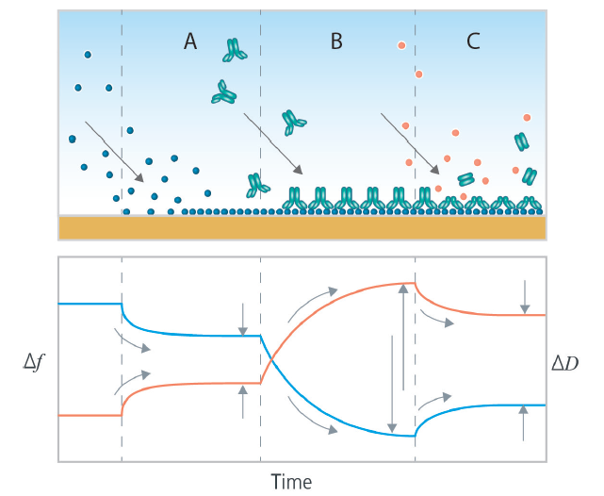
Since the beginning of this century, QSense QCM-D has been used to study viruses and virus-interaction with their immediate surrounding. Here we give examples of virus-related research where QCM-D technology has been used.
QCM-D, which is a surface-sensitive technology, has been used to explore and characterize various aspects of biological systems for more than two decades.1-3 The time-resolved information of mass change at the surface can be used to study biomolecular interactions such as surface-protein, lipid-protein and protein-protein interactions, Fig. 1, and reveal, for example, interaction patterns as a function of molecules, surface and solvent conditions.
An area where such information is useful is in virus-related research. In this field, QCM-D technology has been used to shed light on several different aspects of virus behavior and interaction with the surrounding. Over the years, a vast range of viruses have been studied, for example Norovirus, Poxvirus, Rotavirus, Herpesvirus, Ebola, Hepatitis C and Zika virus.

Figure 1. Schematic illustration of how the QCM-D response can be used to reveal biomolecular interactions such as (top panel) (A) adsorption, (B) binding and (C) enzymatic action. The Δf and ΔD data (bottom panel) reflect time-resolved mass uptake and layer softness respectively and can also be used to quantify the layer thickness.
QCM-D analysis is used in both basic and applied research. The aim could for example be to gain increased knowledge and to get a fundamental understanding of virus behavior and interaction patterns in a certain context. In more applied work, the aim could for example be to develop antiviral therapies.
In the overview below, we have compiled a list of examples of virus-related publications where QCM-D technology has been used. Download the overview to learn more
Compared to QCM, QCM-D measures an additional parameter, and provides more information about the system under study.
Discover how QCM-D analysis reveals real-time etching dynamics, helping optimize cleaning processes and protect surfaces from unwanted damage.
Discover how QSense QCM-D helps tackle fouling challenges across industries
Discover how QCM-D enables real-time, label-free analysis of supported lipid membrane formation, structure, and dynamics for advanced research
Learn how QSense QCM-D analysis can reveal membrane fouling dynamics and optimize cleaning strategies for more efficient water treatment
Learn how QSense QCM-D helps detect and prevent surface-induced instabilities in biologics. Join our webinar for insights and practical examples.
Learn about the top QSense sensors for analyzing biopharmaceutical drug-surface interactions in the context of IV bags.
Learn about QCM-D, Quartz Crystal Microbalance with Dissipation monitoring - an analytical tool for surface interaction studies at the nanoscale.
Explore QSense QCM-D sensors to optimize cleaning efficiency with real-time insights, enhancing formulations and protocols across various conditions.
